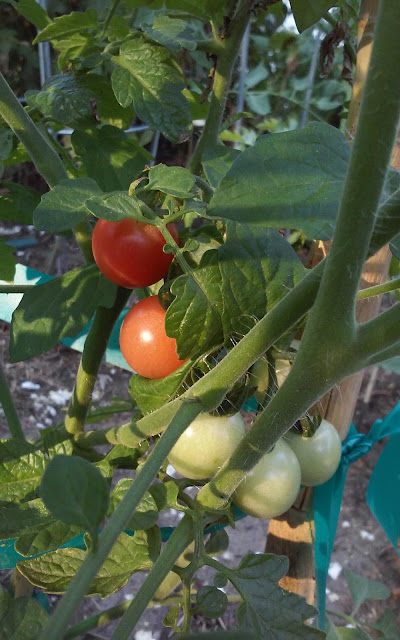 |
| The north bed. This is the Sunpeach plant. |
It's been about a month since I last posted and that's because our tomatoes aren't doing the best. This morning I ripped up the north bed, even though there was new growth and possible tomatoes to come because the blight wasn't too far behind. My logic was why wait for a few small tomatoes to hopefully ripen when I could go ahead and get started on some greens and lettuces for the fall.
Over the past month I've been trying to save these tomato plants but nothing seems to work. It's been a rainy and humid year, so the blight just spreads no matter what. I did slow it down, but then the squirrels arrived. In less than a day all of our green, almost ready to ripen tomatoes were stolen from their vines and eaten by rude, thieves. So now, there are new tomatoes beginning but their branches are full of blight and by the time they ripen they will be half rotten anyway. So I pulled the plants. It was hard to do, but something that needed to be done.
The south bed is doing a little bit better in regards to blight.
 |
| Squash bugs! |
There are small amounts of it on the bottoms of the plants, but I've given up pulling those leaves. Now I've been using that Fertilome spray, which seems to affect the insects and other wildlife very minimally. I tried spraying it on some squash bugs and they seemed unbothered by it, even a few hours later. So that's a good sign, except those bugs are still there, I guess.
The butternut squash is still growing baby squash and right now we have at least eight fully grown squash we are letting age a bit on the vine so we can store them overwinter. We
 |
| South bed. |
have a minor problem with some squash bugs, but now that Ryan knows what they are and what their eggs look like (little black dots on the underside of squash leaves, usually in perfect little rows) we can combat them. But right now, our squash plant is going crazy so a few bugs won't hurt. We just can't let them get out of control.
 |
| Good sized muskmelon |
I picked our first cantaloupe last week. The excess rain this year helped that one right along. Our muskmelon was sweet, juicy and the texture was just perfect, not like store bought. It was a pretty good size, too. There are three or four more out on the vine, but that last one is gonna be small. That's okay though, I'm still excited for it. Sometimes smaller fruit is better.
Over the past couple weeks Ryan and I have been trying to preserve as much food as we can. My mother's friend Annie has an apple tree that her family can't pick because they have disabilities and can't go climb a ladder and pick the apples, so we do it. This year we got nine crates of apples. I am not sure what kind of apples they are, but I do know they make great apple sauce and apple butter.
I've also taken up pickling. A lady Ryan works with brought a bunch (like a LOT) of cucumbers to
work for whoever so Ryan brought them home and I pickled them. I did whole dill, spears and chips as well as some bread and butter pickles. I added some red pepper and chilis to a few of the jars in hopes those will be spicy. After the brine cooled it smelled spicy, so there is hope.
The dill recipe I found is simple and it's actually made for dilling green tomatoes but I figured it
Sean Brock's Heritage, and the recipe is Dilled Green Tomatoes on page 230. If anyone is interested in this recipe, please ask. I'll send it to you.
could work on pickles, too. And it did. I pulled out a jar at a party a couple weeks ago and everyone said they were good on their pulled pork sandwiches. I plan to use them for catering in the upcoming months when we do pulled pork buffets. I think that will be a nice touch to our catering, don't you? Here's the book I got the recipe from:
So, although I've been a canning fool, none of that stuff has actually come from my own garden. Our tomatoes were stolen, the ones that weren't were killed by a nasty fungus and we haven't gotten enough of anything else to can. It's a little depressing but I feel like we will be prepared for next year. At least, as prepared as we can be!
In other news, I was on Facebook last night and saw a friend who posted a picture of a pressure cooker, never used for $50. Originally $100. I jumped on that! Brought it home last night and figured out it can be used as a cooker or a pressure canner! Steal! I can now plan a garden next year and not worry about if I have the equipment to can it all. Now I do! I think Ryan and I are going to mess around with canning beans, soup and other stuff like that. Stay tuned!

